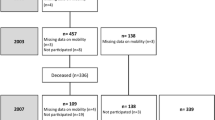Abstract
By corroborating cross-sectional with longitudinal analyses, this study illustrates how cohort effects can confound trends over age and time. Mobility (walking difficulties) and edentulousness (toothlessness) were studied from 1968 to 2002 in a nationally representative panel aged 18–75 (5 waves, n ≈ 5,000) and ages 77+ at later waves (2 waves, n ≈ 500). Three analyses were done: cross-sectional 10-year age group differences in 5 waves, time-lag differences between waves (shifts across time) for age groups, and within-cohort differences between waves for 10-year birth cohorts followed over time. Complementary age-period-cohort models using logistic regression analysis evaluated differences. Both mobility and edentulousness have earlier been shown to be strongly related to age cross-sectionally. For mobility, cross-sectional and longitudinal analyses showed large changes, whereas time-lag analysis indicated no or marginal changes. Both cross-sectional and longitudinal results showed an exponential curvilinear age dependency for mobility limitations, with limitations becoming more usual in older ages. In contrast, cross-sectional and time-lag analyses of edentulousness showed large differences, whereas longitudinal analysis indicated no or marginal changes. Rates of edentulousness became increasingly lower for successively later cohorts in a curvilinear fashion. These patterns demonstrate that age effects dominated mobility, whereas cohort effects dominated edentulousness. Age-period-cohort models confirmed these findings. The cohort effect of edentulousness implies that the cohorts’ movement through time gives a false impression of age and period effects in cross-sectional data.


Similar content being viewed by others
References
Ahacic K, Thorslund M (2006) Changes in edentulousness and dental care utilization in the Swedish population over three decades: Age, period, or cohort effects? Community Dent Oral Epidemiol (in press)
Ahacic K, Barenthin I, Thorslund M (1998) Changes in Swedish dental health 1968–91. Swed Dent J 22:211–222
Ahacic K, Parker MG, Thorslund M (2000) Mobility limitations in the Swedish population from 1968 to 1992: age, gender and social class differences. Aging Clin Exp Res 12:190–198
Ahacic K, Parker MG, Thorslund M (2003) Mobility limitations 1974–1991: period changes explaining improvement in the population. Soc Sci Med 57:2411–2422
Ainamo A, Osterberg T (1992) Changing demographic and oral disease patterns and treatment needs in the Scandinavian populations of old people. Int Dent J 42:311–322
Dannefer D (1984) Adult development and social theory: a paradigmatic reappraisal. Am Sociol Rev 49:100–116
DeMaris A (2002) Explained variance in logistic regression. A Monte Carlo study of proposed measures. Sociol Methods Res 31:27–74
Donaldson G, Horn JL (1992) Age, cohort, and time development muddles: easy in practice, hard in theory. Exp Aging Res 18:213–222
Erikson R, Åberg R (1987) Welfare in transition: a survey of living conditions in Sweden 1968–1981. Clarendon, Oxford
Freedman VA, Martin LG, Schoeni RF (2002) Recent trends in disability and functioning among older adults in the United States: a systematic review. JAMA 288:3137–3146
Glenn ND (1977) Cohort analysis. Sage, Beverly Hills
Holford TR (2006) Approaches to fitting age-period-cohort models with unequal intervals. Stat Med 45:977–933
Holst D, Schuller AA (2000) Oral health changes in an adult Norwegian population: a cohort analytical approach. Community Dent Oral Epidemiol 28:102–111
Lundberg O, Thorslund M (1996) Fieldwork and measurement considerations in surveys of the oldest old. Soc Indic Res 37:165–187
Macintyre S (1997) The Black Report and beyond: what are the issues? Soc Sci Med 44:723–745
Osterberg T, Carlsson GE, Sundh V (2000) Trends and prognoses of dental status in the Swedish population: analysis based on interviews in 1975 to 1997 by Statistics Sweden. Acta Odontol Scand 58:177–182
Palmore E (1978) When can age, period, and cohort be separated? Soc Forces 57:282–295
Parker MG, Ahacic K, Thorslund M (2005) Health changes among Swedish oldest old: Prevalence rates from 1992 and 2002 show increasing health problems. J Gerontol A Biol Sci Med Sci 10:M1351–M1355
Robertson C, Gandini S, Boyle P (1999) Age-period-cohort models: a comparative study of available methodologies. J Clin Epidemiol 52:569–583
Robine JM, Michel JP (2004) Looking forward to a general theory on population aging. J Gerontol A Biol Sci Med Sci 59:M590–M597
Ryder NB (1965) The cohort as a concept in the study of social change. Am Sociol Rev 30:843–861
SAS Institute (1994) SAS user’s guide. SAS Institute, Cary
Schaie KW (1965) A general model for the study of developmental problems. Psychol Bull 64:92–107
Schaie KW, Willis SL (2002) Adult development and aging. Prentice Hall, Upper Saddle River
Suominen-Taipale AL, Alanen P, Helenius H, Nordblad A, Uutela A (1999) Edentulism among Finnish adults of working age, 1978–1997. Community Dent Oral Epidemiol 27:353–365
Truin GJ, Konig KG, Kalsbeek H (1993) Trends in dental caries in The Netherlands. Adv Dent Res 7:15–18
Vrbic VL (1995) The prevalence of dental caries in Slovenia in 1987 and 1993. Community Dent Health 12:39–41
Acknowledgments
This research was performed with financial support from the Swedish Council for Working Life and Social Research (grants 2003-0539 and 2003-0515) and the Swedish Research Council (grant 2005-2182).
Author information
Authors and Affiliations
Corresponding author
Rights and permissions
About this article
Cite this article
Ahacic, K., Parker, M.G. & Thorslund, M. Aging in disguise: age, period and cohort effects in mobility and edentulousness over three decades. Eur J Ageing 4, 83–91 (2007). https://doi.org/10.1007/s10433-007-0049-1
Published:
Issue Date:
DOI: https://doi.org/10.1007/s10433-007-0049-1




